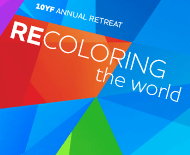Future Now
The IFTF Blog
From #10YF2014: Global Microbiome Map

The last few years have redefined our understanding of how humans and bacteria interact. We now know that the bacterial cells in our bodies outnumber our human cells 10 to 1. We also know that each person has a unique microbial fingerprint, which is constantly changing in response to the microbes in our diet, our environment, and on the people around us. What if we could map the microbiome around the world and in relationship to us—in real time?
The 2014 Ten-Year Forecast Annual Retreat explored the landscape of change over the next decade by inviting attendees to contemplate ten projects that—if successfully undertaken today—could change the paradigm in their fields in the next ten years. These bold projects are already taking shape in the dark underside of the internet, in the foundations of our global cities, in the no-man’s land of our prisons, and in the microbes of our bodies and our planet. They are rapidly recoloring our world.
During this retreat on May 1-2, 2014, Kathi Vian and Ben Oppenheim explored the potential for real-time maps of the microbial world to transform the way that we practice medicine, agriculture, and protect public health.
The vision of a Global Microbiome Mapping project is driven by two questions:
- What would we learn if we created a high-resolution, high-frequency map of our microbial world—from our bodies, to our cities, to our atmosphere?
- How would microbiome mapping shift the way that we interact with our environment?
The goal of this project is to create a dynamic, biogeographic map that would allow us to scan microbial environments and flows at multiple scales. Ambitious? Absolutely. Mapping the microbiome will require new sensing infrastructures able to rapidly sample, process, and analyze microbial populations. But we are already seeing signals of how such a system might emerge.
Two of the most intriguing models are co-led by Jack Gilbert, who joined the conversation at the 2014 Ten-Year Forecast retreat:
- The American Gut Project is pioneering crowdsourced sample collection. People across the country provide skin, mouth, and gut bacteria samples, which are then sequenced and analyzed by volunteers. Together, these samples are building a massive database of information on the links between diet, lifestyle, and individual microbial ecologies.
- The Earth Microbiome Project is mapping microbiomes across a range of environments, from homes, to hotels, to hospitals. The project is uncovering how rapidly bacterial ecosystems change—and how quickly human beings put their own bacterial signatures on the spaces we inhabit.
If these kinds of platforms integrate and scale up, we might expect dramatic changes to familiar industries:
- Medicine will increasingly treat the microbiome, cultivating healthy and balanced individual bacterial ecologies through targeted alternatives to antibiotics.
- Autonomous bio-sensing networks will scan for dangerous bacterial blooms and pathogenic threats to public health.
- Agriculture will be microbially optimized, with food production, nutrition, and bacterial content tailored to specific diets and tastes.
Together, these changes will re-define the way we interact with our most intimate life partners: the bacterial communities that inhabit and co-habit our bodies and environment.
This post is from our 2014 Ten-Year Forecast, which explores 10 bold projects that have the potential to change the world over the next 10 years. In the coming weeks, look for more about the projects and the futures they would make.
Curious about the Ten-Year Forecast Program?
- Follow the projects at @iftf, #10YF2014, and #10projects10years
- Take a sneak peek at our plans for 2015
- Find out more about the Ten-Year Forecast program
- Check out previous years' Ten-Year Forecast research
- Contact Sean Ness (sness@iftf.org)



